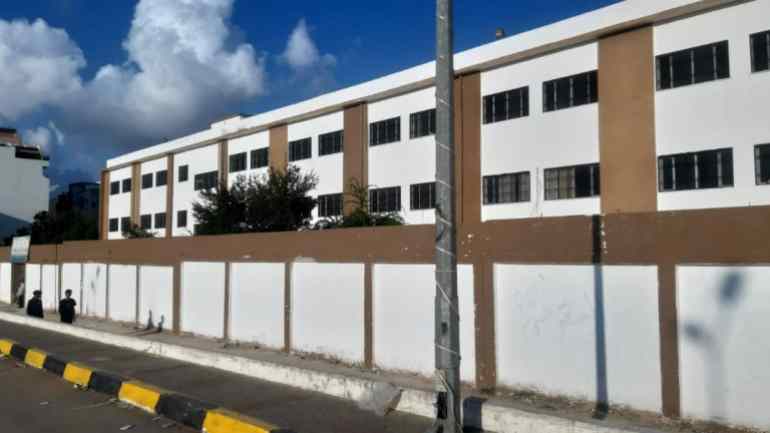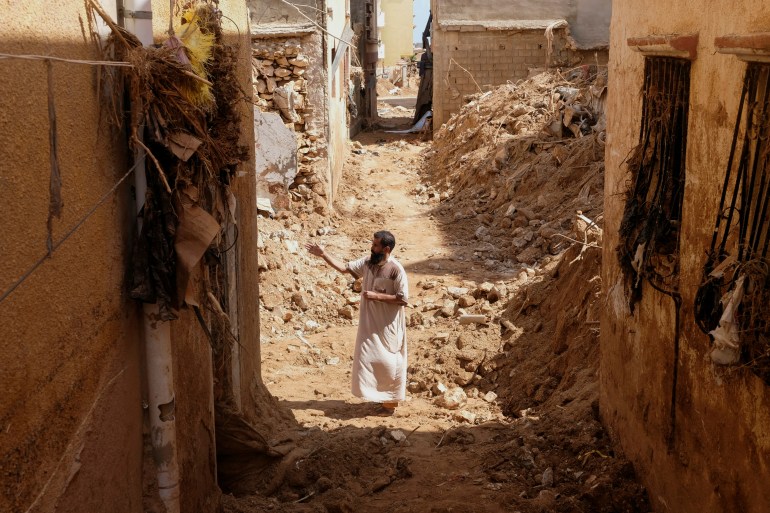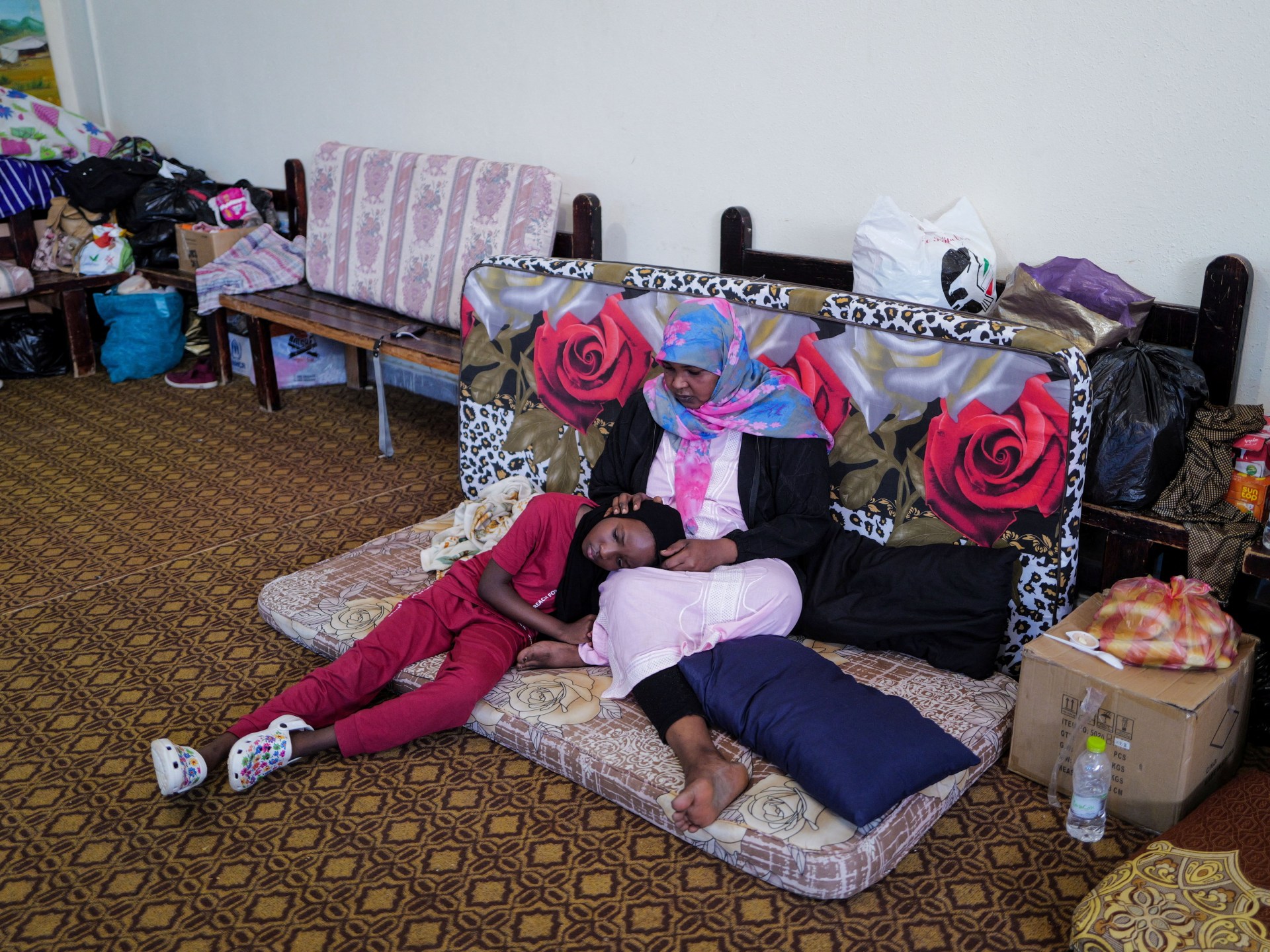Typically, in the course of the night time, Khadijah can hear screaming.
It may very well be the lady within the classroom subsequent door, who has refused to vary out of her abaya since Libya was hit with lethal floods on September 10. She fears extra floods are on the best way and desires to stay hidden from them, within the perception that her flowing gown will shield her, says Khadijah, 60.
Or maybe it’s any certainly one of many who noticed their mom, father, youngster or grandparent swept into the ocean when the dams burst above the japanese metropolis of Derna, submerging it and its sleeping populace.
“The dwelling are those that suffer; the lifeless are relieved,” Khadijah informed Al Jazeera.
Khadija is certainly one of 1000’s of individuals from the flood-battered metropolis who’ve taken shelter in authorities faculties after their homes have been destroyed. She says she feels humiliated.
“Think about closing your eyes by yourself mattress after which all of the sudden discovering your self mendacity on the chilly flooring of a public faculty,” she stated, wiping away tears.
“I skilled most wars and disasters, [Muammar] Gaddafi’s siege of the town within the Nineteen Nineties, the ISIS [ISIL] conflict in 2016, and the conflict of [Khalifa] Haftar’s forces in 2018, however what occurred now was totally different [and] what got here after it was extra humiliating,” she added solemnly.
Khadija, her kinfolk, the 20 or so different households on the faculty they’re sheltering in, and the a whole bunch sheltering elsewhere at the moment are “local weather refugees”, the casual time period used for these displaced by environmental disasters.

However Derna was itself a refuge for 1000’s of migrants from neighbouring nations, alongside Libya’s personal internally displaced inhabitants who settled within the coastal metropolis from different elements of the nation.
Whereas the explanations they fled differ, climate-induced pressures compound with components equivalent to battle and poverty, a fancy internet driving displacement within the area that may solely proceed within the years to come back, specialists have stated.
Pushed out slowly – or abruptly
Khadija and different Libyans from Derna are entangled on this advanced internet however the stage was already set for the catastrophe that engulfed their houses and family members.
Storm Daniel was as much as 50 instances extra prone to happen and 50 p.c extra intense due to human-caused local weather change, in response to the World Climate Attribution group.
The ailing, mismanaged dams have been a key issue, as effectively.
“It may possibly’t actually be [overstated] how essential the infrastructure concern is, as a result of that’s one of many major catalysts for local weather displacement,” Benjamin Freedman, an analyst on the Center East Institute, informed Al Jazeera.
The failing dams, alongside migrants “who weren’t essentially correctly settled”, created the “good storm for an outrageous humanitarian catastrophe”, he added.
Whereas the flash flood created a sudden push for survivors to flee, most individuals who depart their lands for environmental causes achieve this attributable to “slow-onset circumstances” like multi-year droughts, Aimee-Noel Mbiyozo, a senior analysis marketing consultant on the Institute for Safety Research, informed Al Jazeera.
Earlier than the floods, Libya was host to greater than 705,000 refugees and migrants from greater than 44 nationalities, in response to Michela Pugliese, a migration and asylum researcher at Euro-Med Human Rights Monitor.
Greater than 230,000 of those refugees and migrants have been dwelling in japanese Libya, the a part of the nation devastated by the storm, the bulk having arrived from neighbouring international locations like Chad, Egypt, Niger, Nigeria and Sudan, she added.
Some 8,000 of them lived in Derna particularly, however it’s doubtless that many others have been current and never formally reported, stated Pugliese.
Whereas the explanations they ended up in Libya assorted – many hoping to finally depart to Europe – some left their houses over misplaced livelihoods due to local weather disasters.
“Lots of people coming [to] Libya from Chad, Sudan, and Niger have been employed within the agricultural sector at residence and got here to Libya after having misplaced crops or livestock property attributable to local weather occasions like drought or floods,” Pugliese stated.

Worldwide legislation doesn’t recognise local weather refugees
Discerning simply what number of of Derna’s 8,000 refugees have been local weather refugees, and what number of Libyans have now grow to be local weather refugees because of the floods, is a problem – largely as a result of that time period doesn’t exist below worldwide legislation.
“This time period has no authorized foundation below refugee legislation but, so neither UNHCR [the UN refugee agency] registering asylum seekers, nor authorized desks aiding migrants, would use this as an official class,” stated Pugliese.
Mbiyozo added that individuals who transfer for climate-linked causes not often establish it as such.
“We ask individuals, why have you ever moved and so they nearly by no means say, ‘local weather change’,” she stated.
“They’re going to let you know it’s to discover a higher financial alternative, so that they’re transferring for jobs or for livelihood. However then you need to go a degree deeper and say, ‘Effectively, what’s modified?’”
In West Africa, for instance, a refugee could also be fleeing Boko Haram as a result of the armed group took their cattle attributable to dwindling assets, she stated.
Local weather change within the context of migration, subsequently, is a “fragility amplifier or a risk amplifier”, stated Mbiyozo.
Freedman stated that, as local weather disasters grow to be extra widespread, there must be a system in place to establish individuals fleeing due to them.
When these teams of individuals try to assert asylum in Western international locations particularly, they’re denied at a a lot a lot larger fee because of the arbitrariness of the class, he stated.
However the scenario will solely proceed to worsen, “particularly once we’re coping with doubtlessly 1.2 billion individuals displaced internally and externally by intensifying local weather climate occasions by 2050,” Freedman added.
Mbiyozo argued, nonetheless, that if the legal guidelines have been rewritten, particularly the UN Refugee Conference of 1951, a number of Western international locations “would pull again what they presently supply”.
“All people within the refugee house is aware of intuitively that should you have been to redraw this stuff, you get much less safety as a result of that’s the political local weather proper now,” she stated, including that Italy, for instance, is attempting to disclaim as many asylum seekers as it could possibly.

‘Nothing however guarantees’
Regardless of an unwillingness from Western international locations to tackle new classes of refugees, specialists say most climate-linked motion stays native, with many pushed from rural areas to city cities.
Among the many 40,000 individuals displaced in Libya’s floods, many moved to cities and villages additional east and a number of other hundred moved west, stated Pugliese.
Amongst them, are the “twice-displaced” too, pushed from their international locations to Libya, after which pushed once more from Derna to elsewhere.
“It’s far too early to inform what is going to occur to [these displaced peoples], as for now the response remains to be purely a humanitarian one,” stated Pugliese.
Again in Derna, Khadijah is resolute that she and her household can not keep on the faculty for much longer.
Pulling certainly one of her granddaughters shut, she requested: “What is that this youngster’s fault? Youngsters her age are learning in faculties, and she or he lives right here.”
A number of the girls on the faculty maintain again from going to the bathroom attributable to issues about privateness, and the school rooms are frigid at night time despite the fact that winter has but to come back, Khadijah stated.
She says she has “seen nothing however guarantees from the federal government”.
“We live an actual hell,” stated Khadijah.


